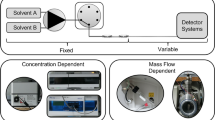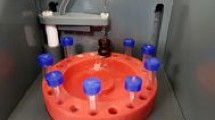Abstract
Minute bioanalytical samples often require special ways of their processing. Here, miniaturized separation techniques play an important role due to their numerous advantages like high separation efficiency, high sensitivity, and possibility of using not typical stationary and mobile phases. In this chapter, the basic information on capillary liquid chromatography and related techniques are presented. The system construction as well as methods of preparation of capillary columns is described. Capillary column packing and synthesis of monolithic stationary phases are also discussed. Examples of using capillary columns in sample preparation are also presented.
Similar content being viewed by others
References
Giddings, J. C. (1965). Dynamics of chromatography; Part I: Principles and theory. Marcel Dekker, Inc.
Giddings, J. C. (1964). Comparison of the theoretical limit of separating ability in gas and liquid chromatography. Analytical Chemistry, 36, 1890–1892.
Horvath, C. G., Preiss, B. A., & Lipsky, S. R. (1967). Fast liquid chromatography. Investigation of operating parameters and the separation of nucleotides on pellicular ion exchangers. Analytical Chemistry, 39, 1422–1428.
Horvath, C. G., & Lipsky, S. R. (1969). Rapid analysis of ribonucleosides and bases at the picomole level using pellicular cation exchange resin in narrow bore columns. Analytical Chemistry, 41, 1227–1234.
Ishii, D., Asai, K., Hibi, K., Jonokuchi, T., & Nagaya, M. (1977). A study of micro-high-performance liquid chromatography: I. Development of technique for miniaturization of high-performance liquid chromatography. Journal of Chromatography A, 144, 157–168.
Takeuchi, T., & Ishii, D. (1980). Ultra-micro high-performance liquid chromatography. Journal of Chromatography. A, 190, 150–155.
Scott, R. P. W., & Kucera, P. (1979). Mode of operation and performance characteristics of microbore columns for use in liquid chromatography. Journal of Chromatography. A, 169, 51–72.
Tsuda, T., & Novotny, M. (1978). Packed microcapillary columns in high performance liquid chromatography. Analytical Chemistry, 50, 271–275.
Tsuda, T., & Novotny, M. (1978). Band-broadening phenomena in microcapillary tubes under the conditions of liquid chromatography. Analytical Chemistry, 50, 632–634.
Chervet, J. P., Ursem, M., & Salzmann, J. P. (1996). Instrumental requirements for nanoscale liquid chromatography. Analytical Chemistry, 68, 1507–1512.
Szumski, M., & Buszewski, B. (2002). State of the art in miniaturized separation techniques. Critical Reviews in Analytical Chemistry, 32, 1–46.
Bhushan, R., & Dubey, R. (2014). Integrated lab-on-chip and mass spectrometry: Recent advances in bioanalysis. Bioanalysis, 6, 1875–1877.
Conde, J. P., Madaboosi, N., Soares Ruben, R. G., Fernandes, J. T. S., Novo, P., Moulas, G., & Chu, V. (2016). Lab-on-chip systems for integrated bioanalyses. Essays in Biochemistry, 60, 121–131.
Mirasoli, M., Guardigli, M., Michelini, E., & Roda, A. (2014). Recent advancements in chemical luminescence-based lab-on-chip and microfluidic platforms for bioanalysis. Journal of Pharmaceutical and Biomedical Analysis, 87, 36–52.
Oedit, A., Vulto, P., Ramautar, R., Lindenburg, P. W., & Hankemeier, T. (2015). Lab-on-a-Chip hyphenation with mass spectrometry: Strategies for bioanalytical applications. Current Opinion in Biotechnology, 31, 79–85.
Ishii, D. (1988). Introduction to microscale high-performance liquid chromatography. VCH Publishers.
Gama, M. R., Collins, C. H., & Bottoli, C. B. G. (2013). Nano-liquid chromatography in pharmaceutical and biomedical research. Journal of Chromatographic Science, 51, 694–703.
Needham, S. R., & Valaskovic, G. A. (2015). Microspray and microflow LC–MS/MS: The perfect fit for bioanalysis. Bioanalysis, 7, 1061–1064.
Wilson, S. R., Vehus, T., Berg, H. S., & Lundanes, E. (2015). Nano-LC in proteomics: Recent advances and approaches. Bioanalysis, 7, 1799–1815.
Fröhlich, T., & Arnold, G. J. (2009). A newcomer’s guide to nano-liquid-chromatography of peptides. In J. Reinders & A. Sickmann (Eds.), Proteomics: Methods and protocols (pp. 123–141). Humana Press.
Rogeberg, M., Malerod, H., Roberg-Larsen, H., Aass, C., & Wilson, S. R. (2014). On-line solid phase extraction–liquid chromatography, with emphasis on modern bioanalysis and miniaturized systems. Journal of Pharmaceutical and Biomedical Analysis, 87, 120–129.
Rieux, L., Sneekes, E.-J., Swart, R., & Swartz, M. (2011). Nano LC: Principles, evolution, and state-of-the-art of the technique. LC-GC North America, 29, 926–934.
Szumski, M., Grzywinski, D., Prus, W., & Buszewski, B. (2014). Monolithic molecularly imprinted polymeric capillary columns for isolation of aflatoxins. Journal of Chromatography. A, 1364, 163–170.
Wahab, M. F., Patel, D. C., Wimalasinghe, R. M., & Armstrong, D. W. (2017). Fundamental and practical insights on the packing of modern high-efficiency analytical and capillary columns. Analytical Chemistry, 89, 8177–8191.
Buszewski, B., Berek, D., & Garaj, J. (1986). Charakterystyka i ocena jakości kolumn stosowanych w wysokosprawnej chromatografii cieczowej (HPLC). Wiadomości chemiczne, 10, 369–396.
Buszewski, B., Berek, D., Novak, I., & Garaj, J. (1987). Optimalizacia podmienok plenia vysokoucinnych kolon pre kvapalinovu chromatografiu. Chemicke Listy, 81, 552–560.
https://www.yumpu.com/en/document/read/14026982/nanobaume-brochure-western-fluids-engineering. Accessed 12 Nov 2020.
Cortes, H. J., Pfeiffer, C. D., Richter, B. E., & Stevens, T. S. (1987). Porous ceramic bed supports for fused silica packed capillary columns used in liquid chromatography. Journal of High Resolution Chromatography, 10, 446–448.
Chen, J.-R., Dulay, M. T., Zare, R. N., Svec, F., & Peters, E. (2000). Macroporous photopolymer frits for capillary electrochromatography. Analytical Chemistry, 72, 1224–1227.
Kato, M., Dulay, M. T., Bennett, B. D., Quirino, J. P., & Zare, R. N. (2001). Photopolymerized sol–gel frits for packed columns in capillary electrochromatography. Journal of Chromatography. A, 924, 187–195.
Hsieh, E. J., Bereman, M. S., Durand, S., Valaskovic, G. A., & MacCoss, M. J. (2013). Effects of column and gradient lengths on peak capacity and peptide identification in nanoflow LC-MS/MS of complex proteomic samples. Journal of the American Society for Mass Spectrometry, 24, 148–153.
New Objective. https://www.newobjective.com/solutions/picofrit/. Accessed 8 December 2021.
Leonardis, I., Capriotti, F., Cappiello, A., Famiglini, G., & Palma, P. (2012). Temperature effects on nano-LC column packing technology. Journal of Separation Science, 35, 1589–1595.
Malik, A., Li, W., & Lee, M. L. (1993). Preparation of long packed capillary columns using carbon dioxide slurries. Journal of Microcolumn Separations, 5, 361–369.
Tong, D., Bartle, K. D., & Clifford, A. A. (1994). Preparation and evaluation of supercritical carbon dioxide-packed capillary columns for HPLC and SFC. Journal of Microcolumn Separations, 6, 249–255.
Rodrigues, J. C., & Lanças, F. M. (2005). Preparation of packed capillary columns using supercritical carbon dioxide on cyclone-type slurry reservoir. Journal of Chromatography. A, 1090, 172–177.
Yan, C. (1995). Electrokinetic packing of capillary columns. US5453163A, USA.
Dadoo, R., Zare, R. N., Yan, C., & Anex, D. S. (1998). Advances in capillary electrochromatography: Rapid and high-efficiency separations of PAHs. Analytical Chemistry, 70, 4787–4792.
Hong, T., Yang, X., Xu, Y., & Ji, Y. (2016). Recent advances in the preparation and application of monolithic capillary columns in separation science. Analytica Chimica Acta, 931, 1–24.
Masini, J. C., & Svec, F. (2017). Porous monoliths for on-line sample preparation: A review. Analytica Chimica Acta, 964, 24–44.
Svec, F., & Lv, Y. (2015). Advances and recent trends in the field of monolithic columns for chromatography. Analytical Chemistry, 87, 250–273.
Wu, R. A., Hu, L., Wang, F., Ye, M., & Zou, H. (2008). Recent development of monolithic stationary phases with emphasis on microscale chromatographic separation. Journal of Chromatography. A, 1184, 369–392.
Hjertén, S., Liao, J.-L., & Zhang, R. (1989). High-performance liquid chromatography on continuous polymer beds. Journal of Chromatography. A, 473, 273–275.
Buszewski, B., Dziubakiewicz, E., & Szumski, M. (2012). Techniki elektromigracyjne: teoria i praktyka. Wydawnictwo MALAMUT.
Courtois, J., Szumski, M., Byström, E., Iwasiewicz, A., Shchukarev, A., & Irgum, K. (2006). A study of surface modification and anchoring techniques used in the preparation of monolithic microcolumns in fused silica capillaries. Journal of Separation Science, 29, 14–24.
Szumski, M., & Buszewski, B. (2014). Preparation of monolithic capillary chromatographic columns using supercritical fluid as a porogen solvent. Chromatographia, 77, 1009–1017.
Luo, Q., Shen, Y., Hixson, K. K., Zhao, R., Yang, F., Moore, R. J., Mottaz, H. M., & Smith, R. D. (2005). Preparation of 20-μm-i.d. silica-based monolithic columns and their performance for proteomics analyses. Analytical Chemistry, 77, 5028–5035.
Dulay, M. T., Quirino, J. P., Bennett, B. D., Kato, M., & Zare, R. N. (2001). Photopolymerized sol−gel monoliths for capillary electrochromatography. Analytical Chemistry, 73, 3921–3926.
Wen, J., Guillo, C., Ferrance, J. P., & Landers, J. P. (2006). DNA extraction using a tetramethyl orthosilicate-grafted photopolymerized monolithic solid phase. Analytical Chemistry, 78, 1673–1681.
Svec, F. (2006). Less common applications of monoliths: I. Microscale protein map** with proteolytic enzymes immobilized on monolithic supports. Electrophoresis, 27, 947–961.
Křvenková, J., Bilková, Z., & Foret, F. (2005). Chararacterization of a monolithic immobilized trypsin microreactor with on-line coupling to ESI-MS. Journal of Separation Science, 28, 1675–1684.
Author information
Authors and Affiliations
Corresponding author
Editor information
Editors and Affiliations
Section Editor information
Rights and permissions
Copyright information
© 2022 Springer Nature Switzerland AG
About this entry
Cite this entry
Szumski, M., Buszewski, B. (2022). Miniaturization in Separation Techniques. In: Buszewski, B., Baranowska, I. (eds) Handbook of Bioanalytics. Springer, Cham. https://doi.org/10.1007/978-3-030-63957-0_32-1
Download citation
DOI: https://doi.org/10.1007/978-3-030-63957-0_32-1
Received:
Accepted:
Published:
Publisher Name: Springer, Cham
Print ISBN: 978-3-030-63957-0
Online ISBN: 978-3-030-63957-0
eBook Packages: Springer Reference Chemistry and Mat. ScienceReference Module Physical and Materials ScienceReference Module Chemistry, Materials and Physics




